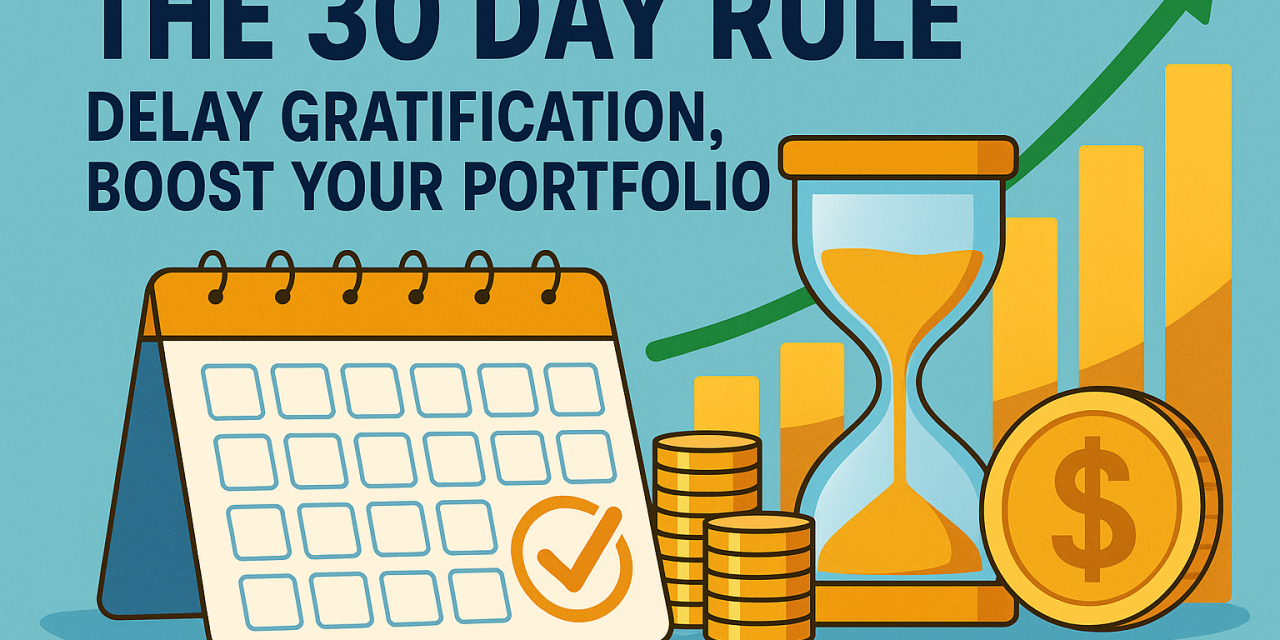The 30‑Day Rule: Delay Gratification, Boost Your Portfolio
A simple waiting period can turn impulse spending into invested wealth—without feeling deprived.
• 8–10 minute read
The 30‑Day Rule is straightforward: when you want to buy a non‑essential item above a chosen dollar amount, write it down and wait 30 days before deciding. If you still want it—and it still makes sense—buy it. If not, redirect the cash to savings or your investment accounts. This small pause counters present bias, reduces buyer’s remorse, and steadily feeds your portfolio.
What is the 30‑Day Rule?
For any non‑essential purchase above your threshold (for example $50, $100, or $250):
- Record the item, price, and a quick “why I want this.”
- Start a 30‑day timer (calendar event or reminder).
- Revisit after 30 days. Buy only if it still provides clear value.
- If you skip it, move the same amount of money into savings or investments.
Why it works (behavioral finance made practical)
Present bias
We overvalue now and undervalue later. A fixed pause shifts the comparison from “now vs. later” to “later vs. later,” making rational choices easier.
Dopamine delay
Impulse buying spikes emotion. Waiting lets the spike fade so utility—not excitement—drives the decision.
Choice clarity
In 30 days you learn whether the need persisted, prices changed, or a better alternative appeared.
Automatic investing
When “no” becomes “invest,” your default behavior builds assets without more willpower.
How to implement it in one afternoon
- Pick thresholds. Example: wait 24 hours for $25–$99, 10 days for $100–$249, 30 days for $250+.
- Set a “30‑Day Wish List.” A simple note, sheet, or the table below works. Include item, date, price, why, and decision.
- Automate the alternative. Create an automatic transfer the moment you decide not to buy (or fund a separate “Deferred Wants” sub‑account weekly).
- Add friction to spending. Remove saved cards from browsers, unsubscribe from promo emails, and delete one‑click payment where possible.
- Define exceptions up front. Essentials, safety‑critical replacements, time‑sensitive repairs, and work tools that clearly raise income can bypass the wait.
- Loop back monthly. Move any “no longer want” dollars into your investment accounts in bulk.
- Track your wins. Seeing dollars diverted to assets reinforces the habit.
The portfolio math: small “no’s” become big “yeses”
Assumptions for illustration: 7% average annual return, compounded monthly. Actual returns vary and are never guaranteed.
| Redirected spending | Time horizon | Estimated future value | Total contributed | Growth |
|---|---|---|---|---|
| $150 per month | 10 years | $25,963 | $18,000 | ≈ $7,963 |
| $300 per month | 10 years | $51,925 | $36,000 | ≈ $15,925 |
| One‑time $1,000 | 30 years | $7,612 | $1,000 | ≈ $6,612 |
| $150 per month | 30 years | $182,996 | $54,000 | ≈ $128,996 |
Method: standard future‑value formulas for periodic contributions and lump sums with 7% nominal annual return; monthly compounding.
Where to put the money you don’t spend
- Build an emergency fund (typically 3–6 months of essential expenses) in a high‑yield savings account.
- Eliminate high‑interest debt. Paying off a 20% APR balance is like earning a risk‑free 20% return.
- Capture employer 401(k) match if available—it’s an instant, often 100%+ return on contributions up to the match limit.
- Tax‑advantaged accounts: 401(k)/403(b), traditional or Roth IRA, and HSA (if eligible) for long‑term growth and potential tax benefits.
- Core investing: broad, low‑cost index funds or ETFs, diversified across U.S. and international markets.
- Automate contributions (weekly or on payday) so “not bought” dollars reach your accounts without manual effort.
Investing involves risk, including loss of principal. Consider your time horizon, risk tolerance, and fees.
30‑Day Wish‑List template
Copy this structure into Notes, Sheets, or your budgeting app.
| Item | Date added | Price | Why I want it | Decision date | Decision | Action |
|---|---|---|---|---|---|---|
| Example: Noise‑canceling headphones | 2025‑11‑25 | $249 | Focus in open office | 2025‑12‑25 | Skip | Invest $249 → Roth IRA |
| Example: Specialty kitchen gadget | 2025‑11‑25 | $120 | Looked cool on TikTok | 2025‑12‑25 | Skip | Add $120 to emergency fund |
FAQ and fine‑tuning
What if a sale ends before 30 days?
Ask yourself: would I want this at full price? If not, it’s the discount talking. If yes, set a reasonable shorter wait (e.g., 7–10 days) for time‑boxed deals you were already planning to buy.
Is 30 days always necessary?
No—calibrate. Many people use 24–72 hours for purchases under $100 and 30 days for larger wants. The bigger the price and the more emotional the purchase, the longer the pause should be.
Does this apply to used or auction items?
Yes, but define your exception rules in advance. If a rare, high‑utility item appears, consider a shorter wait plus a “replacement test”: what problem does it solve, and how often will you use it?
How do I handle gifts or experiences?
Experiences often deliver more lasting satisfaction than things. Use the rule for costly, spontaneous experiences and keep planned traditions.
What if I buy after 30 days and regret it?
Use return policies, and add a new step: wait 24 hours before unboxing big purchases. If doubts linger, return and invest the funds.
Common pitfalls (and fixes)
- Endless carts and “one‑click” checkouts: Remove stored cards; require yourself to re‑enter details.
- Emotional triggers: Avoid browsing when stressed or tired; shop with a list and a budget category.
- Subscription creep: Apply a 30‑day rule to new subscriptions and a 24‑hour rule to add‑ons. Review all subs quarterly.
- Social proof/FOMO: Save the post, add the item to your list, and re‑evaluate in 30 days. Hype fades; needs remain.
Your 60‑second checklist
- Is it essential? If yes, buy. If no, add to the 30‑Day list.
- Will I use it 10+ times in the next 60 days?
- Is there a cheaper, durable, or shared alternative?
- If I skip it, where will the money go today? Name the account.





